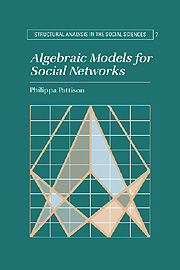Book contents
- Frontmatter
- Contents
- List of figures and tables
- Preface
- 1 Algebraic representations for complete social networks
- 2 Algebraic representations for local social networks
- 3 Comparing algebraic representations
- 4 Decompositions of network algebras
- 5 An analysis for complete and local networks
- 6 Time-dependent social networks
- 7 Algebras for valued networks
- 8 Issues in network analysis
- References
- Appendix A Some basic mathematical terms
- Appendix B Proofs of theorems
- Author index
- Subject index
Preface
Published online by Cambridge University Press: 21 October 2009
- Frontmatter
- Contents
- List of figures and tables
- Preface
- 1 Algebraic representations for complete social networks
- 2 Algebraic representations for local social networks
- 3 Comparing algebraic representations
- 4 Decompositions of network algebras
- 5 An analysis for complete and local networks
- 6 Time-dependent social networks
- 7 Algebras for valued networks
- 8 Issues in network analysis
- References
- Appendix A Some basic mathematical terms
- Appendix B Proofs of theorems
- Author index
- Subject index
Summary
A class of models for analysing social network data are described in this work. The models are offered in response to two related needs arising from current developments in social science research. Firstly, data on social networks are being gathered much more commonly, a fact that is reflected by the inclusion in 1985 of a set of network questions in the General Social Survey (Burt, 1984). As a result, there is a growing need for a variety of models that will enable the analysis of network data in a number of different forms. Secondly, the role of social networks in the development of social and psychological theory is increasingly prominent and calls for the development of data models attuned to a variety of theoretical claims about the nature of that role.
Arguments for the importance of social networks can be found in both the psychological and sociological domains. Social psychologists have documented their dissatisfaction with the “differential” view of social behaviour embodied in many psychological theories (e.g., Cantor & Kihlstrom, 1981; Fiske & Taylor, 1990; Harre & Secord, 1972; Magnusson & Endler, 1977; Moscovici, 1972) and have argued for an analysis of social behaviour that is more sensitive to the “meaningful” context in which it occurs. One aspect of that context is the network of social relations in which the behaviour in question is embedded, a contextual feature to which empirical studies of some kinds of behaviour have already given explicit recognition (e.g., Henderson, Byrne & Duncan-Jones, 1981).
- Type
- Chapter
- Information
- Algebraic Models for Social Networks , pp. xix - xxiiPublisher: Cambridge University PressPrint publication year: 1993



